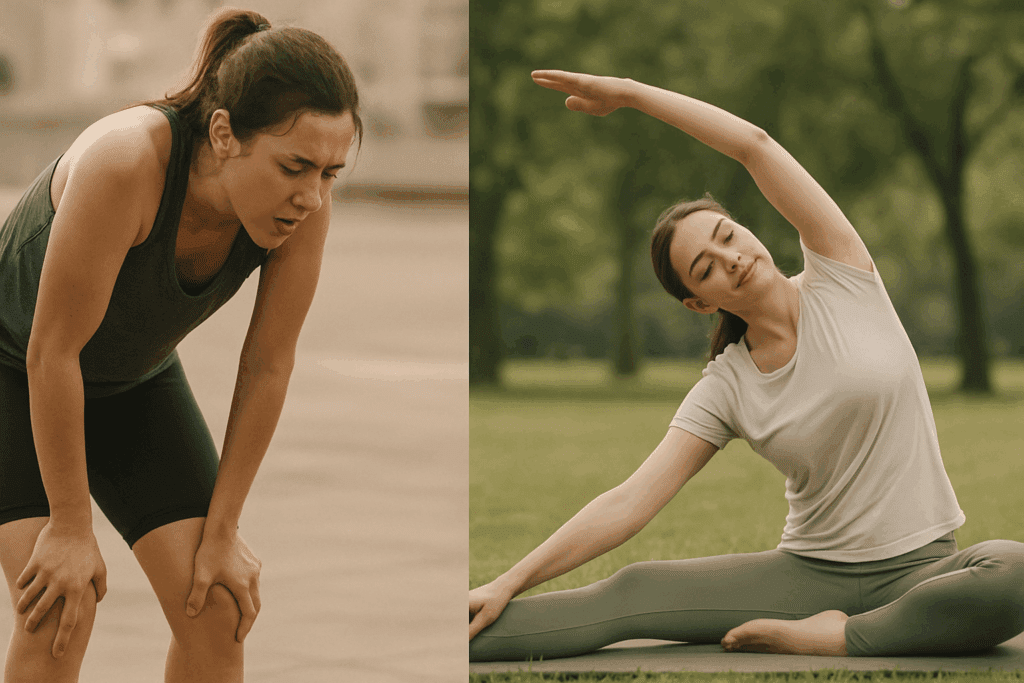Maintaining a consistent physical activity routine is one of the most impactful ways to support long-term health, yet many people remain unsure of exactly how much exercise per day for adults and children is genuinely necessary. In today’s busy world, where responsibilities and distractions compete for time and energy, understanding how to incorporate practical and effective physical activity into a daily routine becomes not just beneficial, but essential. Whether your goal is to boost cardiovascular health, manage weight, improve mental clarity, or simply feel stronger and more energized, the right balance of moderate and vigorous activity can help. This article explores the science-backed recommendations, outlines examples of moderate and vigorous physical activity, and helps you discover ways to integrate movement naturally into your day, whether you’re an adult managing work-life balance or a parent guiding an active child.
You may also like: How to Increase Stamina and Endurance Naturally: Smart Training Tips and Nutrition Habits That Support Cardiovascular Fitness

Understanding Exercise Intensity: Moderate vs. Vigorous Explained
Before diving into specific routines, it’s important to clarify what counts as moderate exercise and what constitutes vigorous physical activity. Exercise intensity is generally measured by how hard the body works during a given activity. Moderate intensity exercise raises the heart rate and breathing rate but still allows for conversation. Vigorous exercise, on the other hand, involves more exertion, significantly increasing heart rate and breathing to a point where talking becomes difficult.
Examples of moderate physical activity include brisk walking, dancing, casual cycling, or doing yard work like raking leaves. In contrast, examples of vigorous exercise someone can do might involve running, swimming laps, jump rope, or playing high-energy sports like soccer or basketball. The distinction matters because combining different intensity levels across the week is key to achieving a well-rounded and sustainable fitness plan. Knowing what is considered moderate intensity cardio, as well as how to recognize when you’re engaging in a vigorous workout, empowers you to better manage your health outcomes.

Guidelines for Adults: How Much Is Enough?
According to the World Health Organization and the Centers for Disease Control and Prevention (CDC), the recommended amount of physical activity for adults involves at least 150 minutes of moderate intensity exercise per week, or 75 minutes of vigorous activity. These guidelines are flexible and can be broken into smaller sessions throughout the day. For example, five 30-minute moderate intensity workouts can easily fulfill the weekly recommendation.
Many adults mistakenly assume that strenuous workouts at the gym are the only way to meet fitness standards, but research suggests otherwise. Activities like brisk walking, water aerobics, and bike riding at a moderate pace can all contribute meaningfully to cardiovascular health and overall fitness. For those looking to push further, incorporating three moderate and three vigorous exercises throughout the week can offer enhanced benefits for endurance, strength, and mood. Understanding what are moderate intensity activities versus vigorous ones makes goal-setting far more accessible.

Fitness for Kids: Setting Healthy Foundations Early
Children require more activity than adults, both for developmental reasons and because of their natural energy levels. The current recommendation for school-aged children and adolescents is at least 60 minutes of moderate to vigorous physical activity each day. This should include muscle-strengthening and bone-strengthening activities at least three times a week.
Examples of moderate and vigorous intensity exercise for kids can vary based on age and preference. Moderate exercise examples include bike riding on level ground or brisk walking to school, while vigorous activities may include playing tag, jumping rope, or organized sports. Encouraging kids to try 3 moderate intensity exercises that someone can do, such as playground games, dancing, and rollerblading, alongside more vigorous options, helps to build not just physical health, but also coordination, confidence, and teamwork skills. Instilling these habits early on can prevent sedentary behaviors and establish lifelong wellness patterns.
Examples of Moderate Exercise Someone Can Do Daily
The beauty of moderate activity lies in its accessibility. You don’t need a gym membership or fancy equipment to participate. Common examples of moderate physical activity include brisk walking, gardening, mopping floors, casual bike rides, and even playing catch with a child. If you’ve ever wondered “is walking moderate exercise?” or “what is considered moderate exercise?”, the answer is yes—when done briskly enough to elevate the heart rate without causing breathlessness.
Some of the best 5 moderate exercises that fit easily into daily routines include brisk walking, yoga, dancing, active house cleaning, and recreational swimming. These activities provide benefits ranging from improved heart health to better joint mobility and even enhanced mental clarity. These moderate exercise examples demonstrate that health-supportive movement doesn’t need to be punishing; it simply needs to be consistent and purposeful.

Exploring Vigorous Physical Exercise and Its Benefits
While moderate activity is crucial, there are substantial benefits to including vigorous physical exercise in your routine, particularly for cardiovascular health, fat loss, and metabolic regulation. Vigorous exercise examples include running, spinning classes, martial arts, fast swimming, and aerobic dancing. For people already accustomed to movement, gradually incorporating these high-intensity options can dramatically increase fitness outcomes.
Understanding what is considered vigorous activity can be nuanced. A vigorous workout is not only defined by the activity itself but by the level of effort relative to one’s fitness level. For someone new to fitness, fast-paced walking might feel vigorous, while for a trained athlete, only sprinting qualifies. What counts as moderate exercise for one person may be vigorous for another, which is why personal calibration is important. Nevertheless, examples of vigorous exercise someone can do regularly are accessible and often enjoyable, especially when tied to competitive or group dynamics.
Combining Moderate and Vigorous Activities for Optimal Health
Blending different levels of intensity throughout the week can help avoid plateaus, reduce injury risk, and make routines more sustainable. Incorporating 3 moderate and 3 vigorous exercises within a seven-day window creates a balanced approach that keeps both body and mind engaged. For example, alternating between cycling, strength training, hiking, swimming, yoga, and jogging allows for comprehensive muscular, cardiovascular, and neurological benefits.
Strategically combining examples of moderate and vigorous intensity exercise allows individuals to maintain energy without overtraining. This integrated approach works well for people juggling responsibilities, as even small pockets of time can be optimized with the right movement intensity. Additionally, alternating exercise intensity helps regulate hormones, improve sleep quality, and even boost cognitive performance—benefits especially relevant for adults managing stressful schedules or recovering from sedentary lifestyles.

Addressing Common Questions About Exercise Intensity and Duration
Many people are unsure about how to accurately gauge exercise intensity. A simple way to assess whether you are doing a moderate intensity workout is the talk test: during moderate activity, you can talk but not sing; during vigorous activity, you can say only a few words before needing to breathe. Heart rate monitoring and perceived exertion scales also help, especially for people engaging in more structured fitness programs.
Another common question is, “is walking light or moderate exercise?” The answer depends on speed, terrain, and individual fitness. A slow, leisurely stroll counts as light activity, while brisk walking that gets the heart rate up counts as moderate. For people recovering from injury or managing chronic conditions, walking can be a highly effective form of moderate intensity cardio. What is considered moderate intensity cardio may also include elliptical training or water aerobics, depending on effort level. Knowing how to personalize intensity helps maximize results without overexertion.
Making Time for Exercise: Strategies That Work
Fitting regular activity into a packed schedule can be challenging, but the key lies in consistency over intensity. Adults don’t need to set aside hours at the gym; short bouts of movement, like a 15-minute walk before breakfast and after dinner, can cumulatively meet the daily requirement. For parents, involving children in physical chores, outdoor play, or family fitness challenges makes movement fun and mutually beneficial.
Incorporating 3 moderate intensity exercises that prevent physical inactivity, such as stair climbing, active commuting, and lunchtime walks, into the workday can be surprisingly effective. For those with sedentary jobs, setting timers to stand, stretch, or pace every hour helps reduce risk factors associated with prolonged sitting. Even home environments can become movement-friendly by incorporating stretching, dancing, or short vigorous workouts into downtime. The shift from inactivity to activity doesn’t need to be dramatic; it just needs to be intentional.

Strenuous Activities and When to Use Caution
Strenuous workouts, including high-intensity interval training (HIIT), CrossFit, or long-distance running, can deliver powerful results but must be approached with care. These forms of vigorous physical activity place high demand on the body and require proper recovery to avoid injury or burnout. While they may appeal to goal-oriented individuals, they’re not necessary for everyone. Moderate intensity exercise offers ample benefits and is often more sustainable long-term.
That said, understanding the difference between effective vigorous activity and unnecessarily strenuous activities is essential. Strenuous does not always mean better. Exercise intensity should align with personal fitness goals, health status, and recovery ability. For most people, a vigorous workout a few times per week combined with regular moderate movement is optimal. Listening to the body, using proper form, and gradually progressing in difficulty are all signs of a sustainable fitness approach.
Frequently Asked Questions: Moderate and Vigorous Exercise for Adults and Children
1. How can busy professionals incorporate 5 moderate exercises into a daily schedule without dedicating hours at the gym?
Busy professionals often assume that structured workouts require significant time investments, but many effective options can fit into even the most hectic schedules. For instance, 5 moderate exercises like brisk walking during phone calls, light cycling to work, stair climbing instead of elevators, bodyweight squats during short breaks, and standing desk leg raises can add up throughout the day. These examples of moderate exercise someone can do without special equipment or a gym membership can be seamlessly integrated into daily routines. The key is recognizing that exercise intensity doesn’t need to be overwhelming to be beneficial. In fact, what counts as moderate exercise often reflects consistent effort, not time spent.
2. What are 3 moderate and 3 vigorous exercises that parents and children can enjoy together?
Joint physical activities strengthen family bonds while promoting health. Parents and children can try 3 moderate and 3 vigorous exercises such as dancing together, cycling at a relaxed pace, and taking active nature walks for moderate movement. For vigorous options, consider competitive games like soccer, playing tag, or interval jump rope challenges. These examples of moderate and vigorous intensity exercise allow both generations to move, laugh, and bond, reinforcing the habit of shared physical engagement. Creating a family fitness plan that mixes these activities supports child development while offering stress relief for adults.
3. What is considered moderate intensity cardio when using indoor equipment like treadmills or ellipticals?
When using indoor equipment, what is considered moderate intensity cardio generally involves maintaining a pace that raises your heart rate to 50–70% of your maximum without inducing breathlessness. On a treadmill, this may equate to a brisk walking pace or a light jog. Ellipticals set at low to medium resistance while maintaining continuous movement also qualify. Moderate intensity exercise in these contexts should allow you to carry on a conversation but not sing comfortably. Tracking effort through heart rate monitors or perceived exertion scales can fine-tune your moderate intensity workout for optimal health outcomes.
4. How does exercise intensity impact mental performance and cognitive clarity?
Exercise intensity plays a nuanced role in brain function. Moderate intensity exercise is linked with improved memory, attention, and executive functioning, especially when done regularly. Meanwhile, a vigorous workout can trigger an immediate endorphin release that enhances mood and sharpens mental acuity. However, overly strenuous activities without adequate recovery may cause fatigue and mental fog. Striking a balance between vigorous physical activity and moderate movement is key to leveraging exercise intensity for sustained cognitive benefits. Consider scheduling high-intensity training earlier in the day when mental clarity is most needed, followed by moderate workouts in the evening to promote relaxation.
5. Are there examples of moderate and vigorous physical activities that support bone density and joint health as we age?
Absolutely. For those concerned with aging gracefully, examples of moderate physical activity that enhance bone density include hiking on varied terrain, gardening with lifting tasks, and water aerobics with resistance paddles. In contrast, examples of vigorous exercise someone can do to support skeletal strength might include tennis, running on grass or rubber surfaces, and plyometric routines using bodyweight. These activities stimulate bone remodeling without causing undue strain when tailored appropriately. Alternating between 3 moderate intensity exercises that prevent physical inactivity and more vigorous physical exercise ensures comprehensive musculoskeletal engagement. It’s important to avoid overly strenuous workouts if joints are compromised—customization is key.
6. How can individuals recovering from injury adapt 3 moderate vigorous exercises that someone can do safely?
Recovery doesn’t mean complete rest; strategic movement aids healing. Individuals in rehabilitation phases can try 3 moderate vigorous exercises that someone can do without risking reinjury by focusing on swimming laps at a steady pace, using a recumbent bike with mild resistance, and practicing interval walking that alternates speed. These options balance cardiovascular challenge with joint safety. What is moderate exercise for a healthy person may be vigorous for someone in recovery, so recalibrating expectations is crucial. Consulting a physical therapist ensures that both moderate and vigorous activity are integrated safely into a personalized recovery plan.
7. Why do some people find it easier to maintain consistency with moderate intensity exercise compared to vigorous activity?
Moderate intensity exercise often feels more sustainable because it places less strain on the body and mind. Activities like walking, light dance routines, or slow-flow yoga are less likely to cause injury, burnout, or post-workout fatigue. For many, a moderate intensity workout provides physical benefits without overwhelming their daily energy reserves. In contrast, engaging in a vigorous workout multiple times a week requires strategic recovery, hydration, and advanced planning, which can be barriers to consistency. Incorporating 5 moderate exercises throughout the week builds momentum that helps form long-lasting habits without the psychological pressure of strenuous activities.
8. Is walking light or moderate exercise, and how can it be adjusted to meet different intensity needs?
Walking is unique in that it can span multiple intensity levels depending on pace, incline, and duration. So, is walking light or moderate exercise? It depends on how it’s done. Leisurely strolls on flat surfaces count as light activity, while brisk walks that elevate heart rate into the 50–70% range of your maximum heart rate are considered moderate. Walking uphill, adding hand weights, or incorporating short bursts of speed can elevate a session into the vigorous exercise range for some individuals. This adaptability makes walking a foundational form of both moderate and vigorous activity across age groups.
9. How can educators promote examples of moderate and vigorous exercise in school settings without over-reliance on organized sports?
Incorporating movement beyond competitive sports is essential for inclusivity. Educators can facilitate examples of moderate and vigorous intensity exercise through daily recess obstacle courses, classroom movement breaks, and interactive fitness challenges like scavenger hunts or relay races. Activities like jumping jacks, hula hooping, and power walking laps around school grounds provide opportunities to engage in 3 moderate and 3 vigorous exercises that are fun and accessible. Teaching students what is considered moderate exercise or a vigorous workout using real-life examples helps normalize active lifestyles. This promotes equity in movement for all skill levels while fostering lifelong physical literacy.
10. What are the long-term health implications of consistently engaging in strenuous workouts without balancing with moderate intensity movement?
While strenuous workouts can enhance athletic performance and metabolic fitness, they also carry a risk of overtraining when not balanced properly. Chronic exposure to high-intensity training without adequate rest can lead to hormonal disruption, immune suppression, and chronic fatigue. Alternating with moderate intensity exercise, such as yoga, active recovery walks, or swimming, allows the body to restore while still reaping cardiovascular and mobility benefits. Over time, blending vigorous physical activity with restorative movement helps preserve joint integrity, prevent injury, and promote mental resilience. Establishing a sustainable routine that includes both moderate and vigorous physical exercise ensures not just physical gains, but also emotional and neurological well-being.
Final Thoughts: Finding Your Balance With Moderate and Vigorous Exercise
Ultimately, the question of how much exercise per day for adults and children can be answered not with a one-size-fits-all metric, but with a flexible framework tailored to individual needs. A successful fitness plan doesn’t require extreme effort but rather a thoughtful mix of movement intensities and consistency over time. For adults, this might mean blending 3 moderate and 3 vigorous exercises per week, while for children, it could involve daily play that combines examples of moderate and vigorous intensity exercise in fun, age-appropriate ways.
Understanding what counts as moderate exercise and identifying practical moderate exercise examples like walking, dancing, or gardening can help make movement feel accessible and enjoyable. At the same time, recognizing vigorous exercise examples such as running, swimming, or aerobic classes can add variety and drive progress. Ultimately, what is considered moderate exercise or vigorous activity depends on personal effort and intent—a reminder that exercise is not about comparison, but about connection to one’s body and health.
The real power lies in integrating movement into daily life with purpose and awareness. Whether it’s a moderate intensity workout on your lunch break or a vigorous physical exercise session to boost endorphins, every step matters. By prioritizing physical activity with a mix of intensities and listening to your body’s needs, you can build a lasting foundation of health, energy, and resilience for yourself and your family.
Was this article helpful? Don’t let it stop with you. Share it right now with someone who needs to see it—whether it’s a friend, a colleague, or your whole network. And if staying ahead on this topic matters to you, subscribe to this publication for the most up-to-date information. You’ll get the latest insights delivered straight to you—no searching, no missing out.
Further Reading:
An Overview of Current Physical Activity Recommendations in Primary Care
How much should the average adult exercise every day?
WHO Guidelines on Physical Activity and Sedentary Behaviour.

